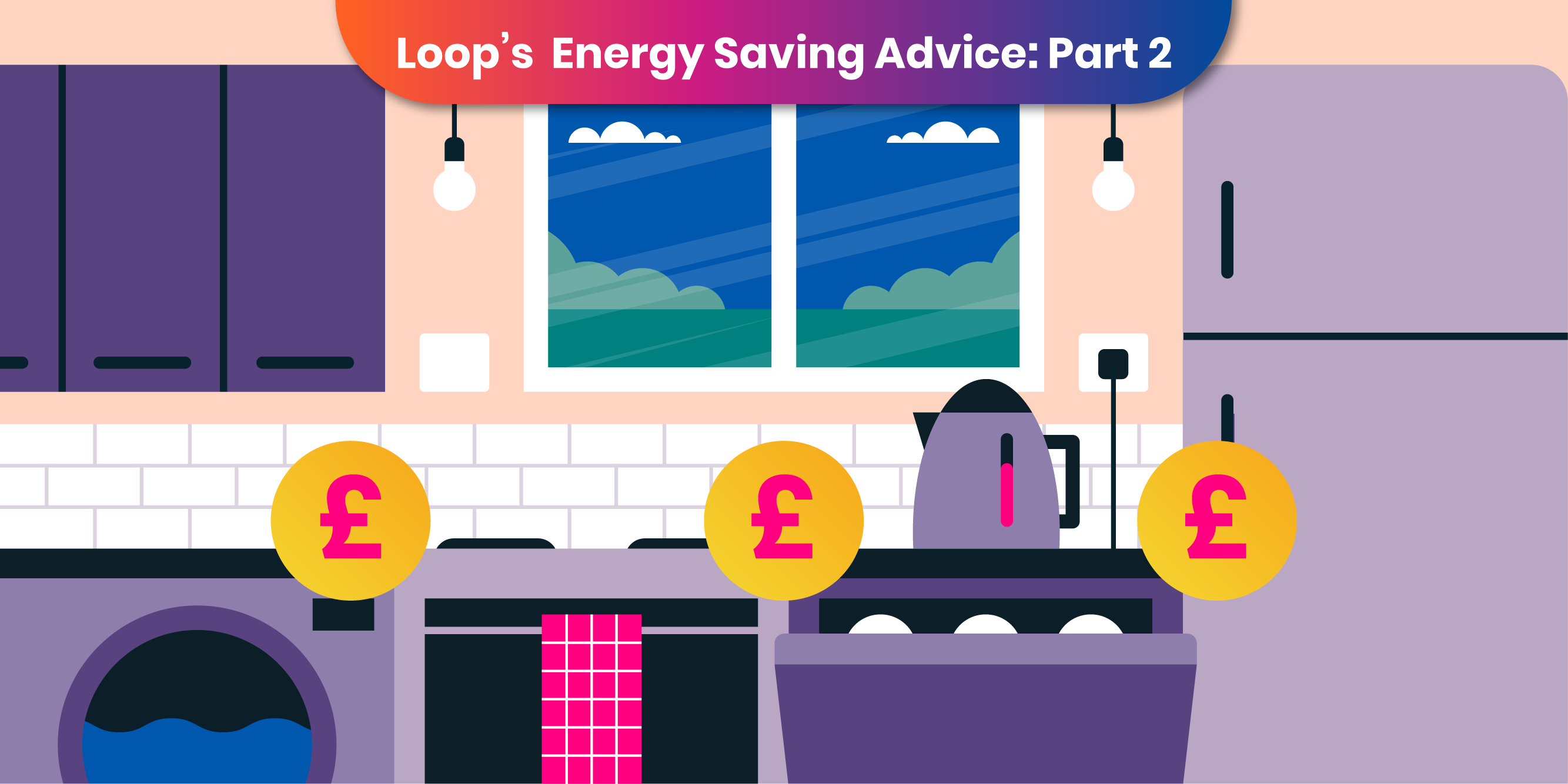Energy Saving Advice - Part 2: Appliance Efficiency
When it comes to using your appliances more efficiently, a good place to start is by understanding how your household is currently using them. Then, you can easily identify how you should be focussing your energy-saving efforts.
While everyone should know to turn lights off when they leave a room, there are plenty of other energy-saving actions that you might not be aware of.
Wasted energy makes up 30% of the average energy bill - do something about it! Get more from your smart meter with Loop.
Here is a rundown of how much your household appliances are costing you, and how you can use them more efficiently to save money on your energy bills.
Tumble Dryer
💸 Cost: Tumble dryer costs vary widely based on efficiency, ranging from £141 a year for an A+++ heat pump dryer to around £480 annually for lower-rated vented and condenser dryers. You could see lifetime savings of up to £4,752 by choosing a heat pump tumble dryer over a model with the lowest efficiency rating.
💡 Tip: Select a model renowned for its energy-saving features. Choosing a heat pump tumble dryer over other variants can be a worthwhile investment and could more than cut your running costs in half!
Use your tumble dryer efficiently by making sure it's adequately filled, without overloading it. For quicker drying times, place a dry tea towel among the laundry load, as it can notably expedite the process. Additionally, maintain the dryer's performance by routinely cleaning filters and ensuring buttons on items like duvet covers are securely fastened, preventing other laundry from getting trapped and hindering proper drying.
Whenever feasible, harness the natural power of the sun by opting to dry clothes outside!
.jpg?width=300&height=300&name=How%20much%20does%20my%20washing%20machine%20and%20tumble%20dryer%20cost%20to%20run%202%20(3).jpg)
Fridge & Freezer
💸 Cost: On average, a fridge freezer costs £79 per year to run. But all fridge freezers aren’t created equally. An E-rated model can have an annual running cost of £108, whereas an A-rated version could cost around £46. The choice between a high or low-rated appliance could unlock lifetime savings of over £1600.
💡 Tip: Remember, a smaller fridge may use less energy than a larger one with the same rating. Look for the yearly energy consumption in kWh/annum on the label to compare appliances.
Keeping your fridge and freezer full helps them to retain the cold better, and they won't have to work as hard. If you don't have enough food, you can always add containers of water. Make sure your fridge is set at the right temperature of 5 degrees Celsius or less, and check there is a gap of around 10cm behind your fridge to let the heat from the radiator on the rear escape more easily.

Washing Machine
💸 Cost: A-rated washing machines cost around £46 a year to run, compared to £71 for D-rated models. Choosing an A-rated washing machine will cost around £100 more to buy than D-rated versions, but will save you around £300 over its lifetime.
💡 Tip: Wash full loads at low temperatures, or on eco-mode, to maximise savings.

Dishwasher
💸 Cost: Running your dishwasher makes up around 8% of your electricity bill. An A-rated dishwasher can save you around £320 over its lifetime compared to the lowest-rated models.
💡 Tip: Make sure your dishwasher is filled for a full load before you use it. Using eco-mode will also make it run as efficiently as possible.

Kettle
💸 Cost: The majority of us boil more water in our kettles than we need to. Overfilling could be adding around £12 a year to your electricity bill.
💡 Tip: Choose a kettle that switches off immediately after boiling and has a low minimum fill level. This means you'll only boil the water you need, which can use up to 20% less energy.

Oven & Hob
💸 Cost: On average, an electric oven costs £62 a year to run.
💡 Tip: Remember, the pyrolytic function for cleaning can increase running costs as it's energy-intensive. Check the energy label on both electric and gas ovens to make the most efficient choice.
💰 Bigger savings: If you have an air fryer, use it over your oven. You can halve your cooking costs as it requires less energy to reach its maximum temperature.

Good Energy Habits
To mop up some of the smaller efficiency savings, make sure you’re not leaving standby appliances on at the plug. Devices like multi-room speakers or your digital TV box can add up considerably over the course of a year, contributing to your Phantom Load.
| Standby appliances | Average annual cost (26p) |
| Digital TV box (left on) | £40 |
| Multi-room speakers (in idle mode) | £30 |
| Router (left on) | £8.13 |
| Microwave (left on) | £0.92 |
| Digital clock (left on) | £2.77 |
| TV (on standby) | £1.35 |
| Coffee maker (left on) | £1.80 |
| Phone charger (plugged in, not charging) | £0.38 |
Next Steps
Now your home is as energy efficient as possible, read Part 3: Big Energy Savers. Find out how your home can go from super-saver to self-sufficient.
Have you read Part 1: Low Effort, High Reward Actions yet? Find out which simple energy-saving actions can benefit your wallet the most.
[Appliance costs used in this article are from Euronics, EnergySavingTrust and Which?.]
• • •
Cut Your Energy Bill With Loop
Loop is a FREE energy-saving app that links to your smart meter, analyses your energy use and shows you easy ways to save. On average, Loop users cut their energy use by 15%! How much could you save?








